"色谱数据报告英文版"相关数据
更新时间:2024-11-262011年残疾人数据世界报告(英文版)
Disability need not be an obstacle to success.l have had motor neurone disease for practically allmy adult life.Yet it has not prevented me from having a prominent career in astrophysics and ahappy family life.
Reading the World report on disability, I find much of relevance to my own experience. I havebenefitted from access to first class medical care. I rely on a team of personal assistants who makeit possible for me to live and work in comfort and dignity. My house and my workplace have beenmade accessible for me. Computer experts have supported me with an assisted communicationsystem and a speech synthesizer which allow me to compose lectures and papers, and to commu-nicate with different audiences.
But I realize that I am very lucky, in many ways. My success in theoretical physics has ensuredthat I am supported to live a worthwhile life. It is very clear that the majority of people with dis-abilities in the world have an extremely difficult time with everyday survival, let alone productiveemployment and personal fulfilment.
l welcome this first World report on disability.This report makes a major contribution to ourunderstanding of disability and its impact on individuals and society. It highlights the differentbarriers that people with disabilities face - attitudinal, physical, and financial.Addressing thesebarriers is within our reach.
In fact we have a moral duty to remove the barriers to participation, and to invest sufficient fund-ing and expertise to unlock the vast potential of people with disabilities. Governments throughoutthe world can no longer overlook the hundreds of millions of people with disabilities who are deniedaccess to health, rehabilitation, support, education and employment, and never get the chance to shine.
The report makes recommendations for action at the local, national and international levels.lt will thus be an invaluable tool for policy-makers, researchers, practitioners, advocates and vol-unteers involved in disability. It is my hope that, beginning with the Convention on the Rights ofPersons with Disabilities, and now with the publication of the Worldreport on disability, this centurywill mark a turning point for inclusion of people with disabilities in the lives of their societies.
【更多详情,请下载:2011年残疾人数据世界报告(英文版)】

 2011年残疾人数据世界报告(英文版)报告首先介绍了残疾情况和残疾衡量方法,然后专章阐述了健康、康复、协助和支持、创造有利环境、教育以及就业等专题。每一章论述了所面临的障碍,并进行了案例研究,表明一些国家如何通过推广良好做法成功地克服了这些障碍。报告最后一章提出了九项具体的政策和行动建议,如果落实这些建议,即可切实改善残疾人的生活。2011年发布时间:2020-09-21
2011年残疾人数据世界报告(英文版)报告首先介绍了残疾情况和残疾衡量方法,然后专章阐述了健康、康复、协助和支持、创造有利环境、教育以及就业等专题。每一章论述了所面临的障碍,并进行了案例研究,表明一些国家如何通过推广良好做法成功地克服了这些障碍。报告最后一章提出了九项具体的政策和行动建议,如果落实这些建议,即可切实改善残疾人的生活。2011年发布时间:2020-09-21 2024薪酬指南(英文版)2024年发布时间:2024-07-09
2024薪酬指南(英文版)2024年发布时间:2024-07-09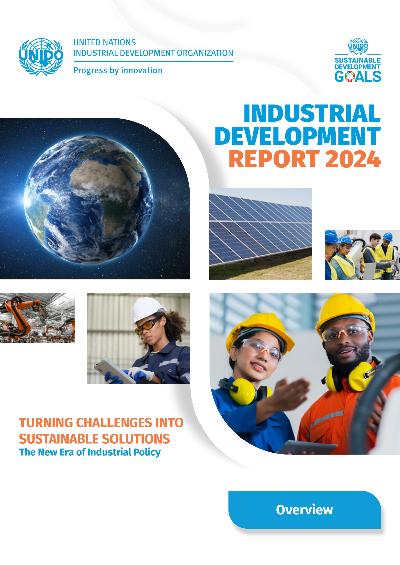 2024工业发展报告(英文版)2024年发布时间:2024-09-11
2024工业发展报告(英文版)2024年发布时间:2024-09-11 2023年云安全报告(英文版)2023年发布时间:2024-08-07
2023年云安全报告(英文版)2023年发布时间:2024-08-07 2003全球非法毒品趋势英文版全球毒品趋势报告是联合国禁毒和预防犯罪办公室从1999年开始编写的年度报告,根据联合国各成员国提供的数据对全世界每年非法麻醉品生产、贩运和消费情况进行统计。本报告为2003年年度报告。2003年发布时间:2020-06-19
2003全球非法毒品趋势英文版全球毒品趋势报告是联合国禁毒和预防犯罪办公室从1999年开始编写的年度报告,根据联合国各成员国提供的数据对全世界每年非法麻醉品生产、贩运和消费情况进行统计。本报告为2003年年度报告。2003年发布时间:2020-06-19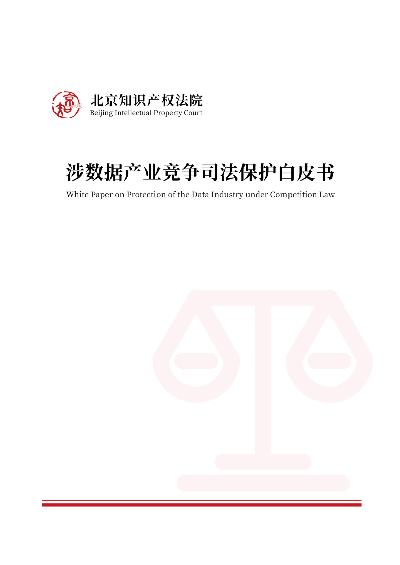 2024涉数据产业竞争司法保护白皮书(中英文版)2024年发布时间:2024-09-20
2024涉数据产业竞争司法保护白皮书(中英文版)2024年发布时间:2024-09-20 1999全球非法毒品趋势(英文版)全球毒品趋势报告是联合国禁毒和预防犯罪办公室从1999年开始编写的年度报告,根据联合国各成员国提供的数据对全世界每年非法麻醉品生产、贩运和消费情况进行统计。1999年发布时间:2020-06-19
1999全球非法毒品趋势(英文版)全球毒品趋势报告是联合国禁毒和预防犯罪办公室从1999年开始编写的年度报告,根据联合国各成员国提供的数据对全世界每年非法麻醉品生产、贩运和消费情况进行统计。1999年发布时间:2020-06-19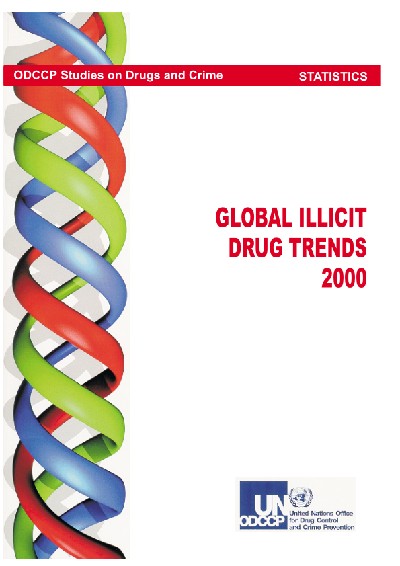 2000全球非法毒品趋势(英文版)本报告为联合国毒品和犯罪问题办公室于2000年发布的2000全球非法毒品趋势。2000年发布时间:2020-06-19
2000全球非法毒品趋势(英文版)本报告为联合国毒品和犯罪问题办公室于2000年发布的2000全球非法毒品趋势。2000年发布时间:2020-06-19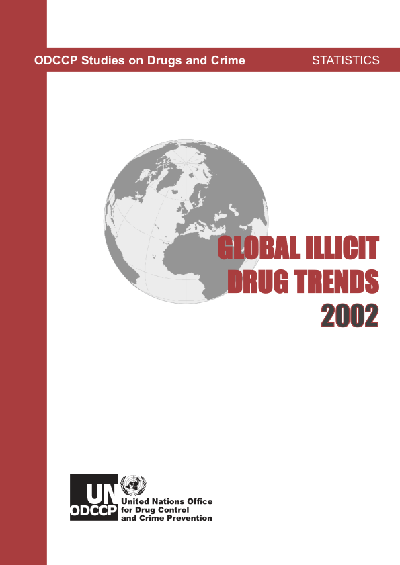 2002全球非法毒品趋势(英文版)报告指出,由于阿富汗禁止鸦片生产,2001年全球鸦片种植面积比前年减少了35%。全球鸦片可能达到的产量由前年的4700吨减少到去年的约1600吨,下降幅度达到65%。但是,联合国禁毒署今年2月份进行的一项调查显示,阿富汗今年的鸦片产量将达到2700吨,相当于上世纪90年代的水平。2002年发布时间:2020-06-19
2002全球非法毒品趋势(英文版)报告指出,由于阿富汗禁止鸦片生产,2001年全球鸦片种植面积比前年减少了35%。全球鸦片可能达到的产量由前年的4700吨减少到去年的约1600吨,下降幅度达到65%。但是,联合国禁毒署今年2月份进行的一项调查显示,阿富汗今年的鸦片产量将达到2700吨,相当于上世纪90年代的水平。2002年发布时间:2020-06-19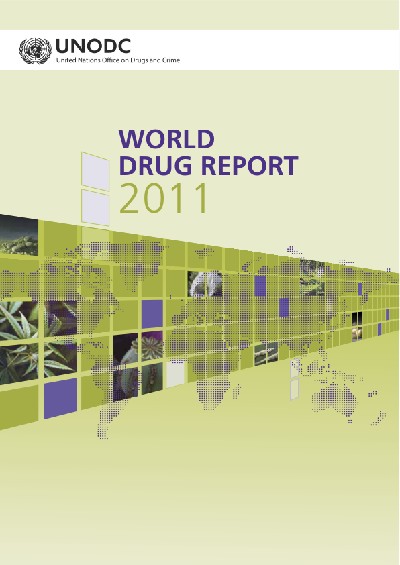 2011世界毒品报告(英文版)本报告为联合国毒品和犯罪问题办公室于2011年发布的2011世界毒品报告。2011年发布时间:2020-06-19
2011世界毒品报告(英文版)本报告为联合国毒品和犯罪问题办公室于2011年发布的2011世界毒品报告。2011年发布时间:2020-06-19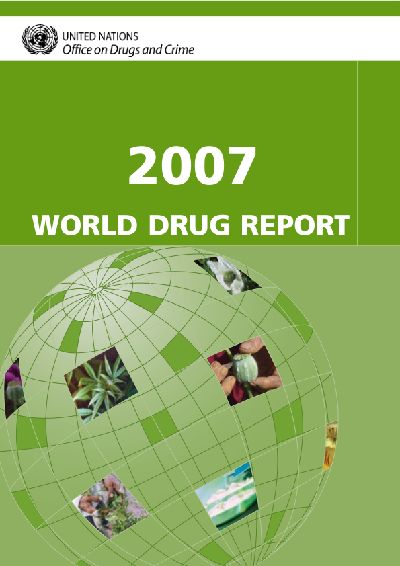 2007世界毒品报告(英文版)本报告为联合国毒品和犯罪问题办公室于2007年发布的2007世界毒品报告。2007年发布时间:2020-06-19
2007世界毒品报告(英文版)本报告为联合国毒品和犯罪问题办公室于2007年发布的2007世界毒品报告。2007年发布时间:2020-06-19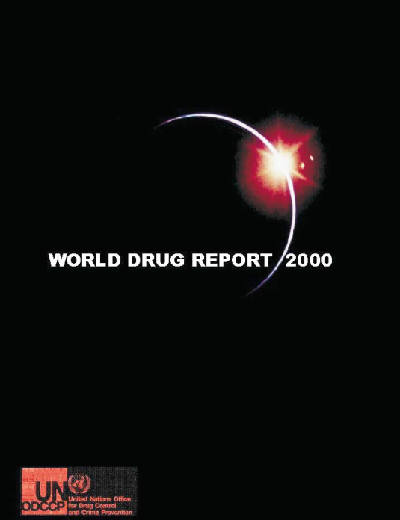 2000世界毒品报告(英文版)本报告为联合国毒品和犯罪问题办公室于2000年发布的2000世界毒品报告。2000年发布时间:2020-06-19
2000世界毒品报告(英文版)本报告为联合国毒品和犯罪问题办公室于2000年发布的2000世界毒品报告。2000年发布时间:2020-06-19 2001全球非法毒品趋势(英文版)联合国禁毒署估计全球有1.85亿人吸毒。2000年吸食大麻的人数增长最多。按地区统计,东欧、中亚和非洲吸食鸦片的人数在增加,西欧、北美相对稳定;美国吸食可卡因的人数在减少,而南美、非洲和欧洲的人数仍在增加,速度有所放慢;欧洲、美洲、非洲和大洋洲吸食大麻的人数总体上在增加,南亚和东南亚则在减少;东亚和东南亚吸食安非他明类兴奋剂的人数增加迅速,而西欧和北美趋于稳定;美洲、东南亚和欧洲部分地区吸食冰毒的人数在增加,欧洲其他地区则趋于稳定。2001年发布时间:2020-06-19
2001全球非法毒品趋势(英文版)联合国禁毒署估计全球有1.85亿人吸毒。2000年吸食大麻的人数增长最多。按地区统计,东欧、中亚和非洲吸食鸦片的人数在增加,西欧、北美相对稳定;美国吸食可卡因的人数在减少,而南美、非洲和欧洲的人数仍在增加,速度有所放慢;欧洲、美洲、非洲和大洋洲吸食大麻的人数总体上在增加,南亚和东南亚则在减少;东亚和东南亚吸食安非他明类兴奋剂的人数增加迅速,而西欧和北美趋于稳定;美洲、东南亚和欧洲部分地区吸食冰毒的人数在增加,欧洲其他地区则趋于稳定。2001年发布时间:2020-06-19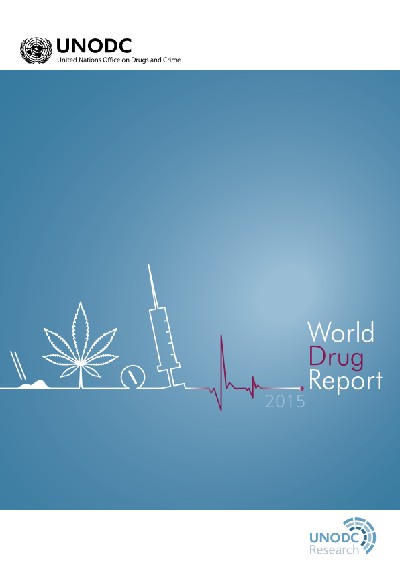 2015世界毒品报告(英文版)本文概述了阿片剂、可卡因、大麻、苯丙胺类兴奋剂和新型精神活性物质供求方面的全球情况及其对健康的影响,审查了各种预防吸毒办法的科学证据,以及讨论了戒毒治疗有效对策的基本原则,重点讨论在更广泛的发展议程中替代发展如何旨在通过为农民提供替代生计而打破非法作物种植的恶性循环。2015年发布时间:2020-06-19
2015世界毒品报告(英文版)本文概述了阿片剂、可卡因、大麻、苯丙胺类兴奋剂和新型精神活性物质供求方面的全球情况及其对健康的影响,审查了各种预防吸毒办法的科学证据,以及讨论了戒毒治疗有效对策的基本原则,重点讨论在更广泛的发展议程中替代发展如何旨在通过为农民提供替代生计而打破非法作物种植的恶性循环。2015年发布时间:2020-06-19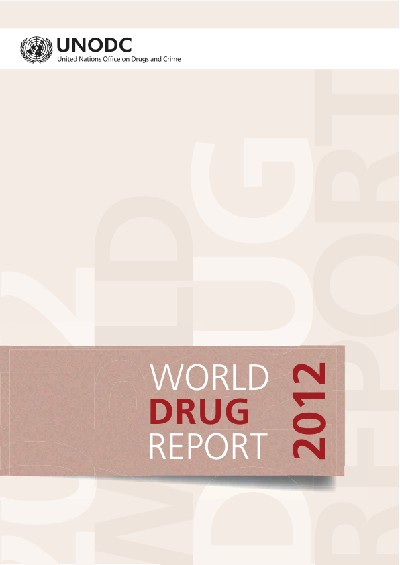 2012世界毒品报告(英文版)可卡因的黄金时代已经结束,合成毒品和其他化学物质的时代已经到来。鸦片和古柯种植面积普遍减少,而合成毒品的产量不断增加。每年造成大约20万人死亡的传统毒品处于稳定状态,当局如今面临新的挑战。大麻制品仍然是需求量最大的、使用最广泛的毒品。有1.19亿至2.24亿人去年至少消费一次大麻制品。安非他明和甲基苯丙胺次之,所占比例在0.3%至1.2%之间。虽然可卡因的产量和种植面积在去年都有所减少,但打击可卡因的斗争仍是一项严峻的挑战,因为全世界仍有1300万至1900万人在消费这种毒品,主要分布在美国和欧洲,还有一些南美国家。美国仍然是可卡因的最大需求国,大约有500万消费者。阿富汗是海洛因等提取自鸦片的毒品最大的生产国。2011年阿富汗的海洛因产量在5800吨左右,占世界产量的61%。非洲和亚洲的消费占70%。2012年发布时间:2020-06-19
2012世界毒品报告(英文版)可卡因的黄金时代已经结束,合成毒品和其他化学物质的时代已经到来。鸦片和古柯种植面积普遍减少,而合成毒品的产量不断增加。每年造成大约20万人死亡的传统毒品处于稳定状态,当局如今面临新的挑战。大麻制品仍然是需求量最大的、使用最广泛的毒品。有1.19亿至2.24亿人去年至少消费一次大麻制品。安非他明和甲基苯丙胺次之,所占比例在0.3%至1.2%之间。虽然可卡因的产量和种植面积在去年都有所减少,但打击可卡因的斗争仍是一项严峻的挑战,因为全世界仍有1300万至1900万人在消费这种毒品,主要分布在美国和欧洲,还有一些南美国家。美国仍然是可卡因的最大需求国,大约有500万消费者。阿富汗是海洛因等提取自鸦片的毒品最大的生产国。2011年阿富汗的海洛因产量在5800吨左右,占世界产量的61%。非洲和亚洲的消费占70%。2012年发布时间:2020-06-19 2013世界毒品报告(英文版)本文将关注焦点聚焦在新型精神活性物质上,对各类毒品的生产、交易和使用情况进行纵览。2013年发布时间:2020-06-19
2013世界毒品报告(英文版)本文将关注焦点聚焦在新型精神活性物质上,对各类毒品的生产、交易和使用情况进行纵览。2013年发布时间:2020-06-19 2010世界毒品报告(英文版)虽然鸦片、古柯的产量正逐年下降,美国吸食毒品的比例出现明显下降;但全世界,特别是欧洲不少发达国家吸毒比例却呈逐年上升趋势,英国、意大利、法国、西班牙等发达国家对海洛因、可卡因以及各种兴奋剂的需求呈逐年增加趋势。1998年,欧洲吸食可卡因的人数为200万,2008年这一数字飙升至410万。2010年发布时间:2020-06-19
2010世界毒品报告(英文版)虽然鸦片、古柯的产量正逐年下降,美国吸食毒品的比例出现明显下降;但全世界,特别是欧洲不少发达国家吸毒比例却呈逐年上升趋势,英国、意大利、法国、西班牙等发达国家对海洛因、可卡因以及各种兴奋剂的需求呈逐年增加趋势。1998年,欧洲吸食可卡因的人数为200万,2008年这一数字飙升至410万。2010年发布时间:2020-06-19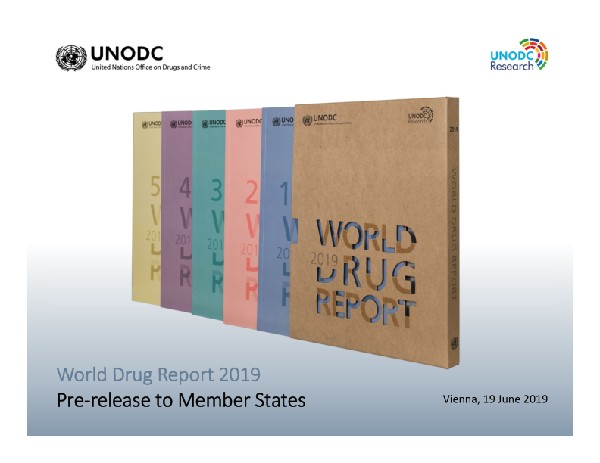 2019年世界毒品报告(英文版)全球3500万人患有药物滥用障碍,仅1/7的人获得治疗。2017年, 约有2.71亿人在前一年使用过毒品,占全球15至64岁的人口的5.5%。全球阿片类药物使用者增加了56%,超过5300万人。非洲、亚洲、欧洲和北美使用阿片类药物比例,以及北美洲、南美洲和亚洲使用大麻的比例比2009年更高。全球2017年非法生产的可卡因数量达1976吨,创历史新高,比前一年增加了25%。同时,2017年全球缉获的可卡因数量增加了13%,达1275吨,是有史以来报告的最大数量。2019年发布时间:2020-06-19
2019年世界毒品报告(英文版)全球3500万人患有药物滥用障碍,仅1/7的人获得治疗。2017年, 约有2.71亿人在前一年使用过毒品,占全球15至64岁的人口的5.5%。全球阿片类药物使用者增加了56%,超过5300万人。非洲、亚洲、欧洲和北美使用阿片类药物比例,以及北美洲、南美洲和亚洲使用大麻的比例比2009年更高。全球2017年非法生产的可卡因数量达1976吨,创历史新高,比前一年增加了25%。同时,2017年全球缉获的可卡因数量增加了13%,达1275吨,是有史以来报告的最大数量。2019年发布时间:2020-06-19 2023年全球教育监测报告(英文版)2023年发布时间:2023-12-12
2023年全球教育监测报告(英文版)2023年发布时间:2023-12-12 2023年全球数字信任状况报告(英文版)2023年发布时间:2023-12-12
2023年全球数字信任状况报告(英文版)2023年发布时间:2023-12-12





